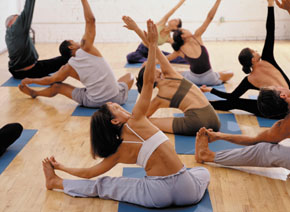Exercise to Age Well, Whatever Your Age
By GRETCHEN REYNOLDS
Offering hope and encouragement to the many
adults who have somehow neglected to exercise for the past few decades, a
new study suggests that becoming physically active in middle age, even
if someone has been sedentary for years, substantially reduces the
likelihood that he or she will become seriously ill or physically
disabled in retirement.
The new study joins a growing body of
research examining successful aging, a topic of considerable scientific
interest, as the populations of the United States and Europe grow older,
and so do many scientists. When the term is used in research,
successful aging means more than simply remaining alive, although that,
obviously, is the baseline requirement. Successful aging involves
minimal debility past the age of 65 or so, with little or no serious
chronic disease diagnoses, depression, cognitive decline or physical
infirmities that would prevent someone from living independently.
Previous epidemiological studies have found
that several, unsurprising factors contribute to successful aging. Not
smoking is one, as is moderate alcohol consumption, and so, unfairly or
not, is having money. People with greater economic resources tend to
develop fewer health problems later in life than people who are not
well-off.
But being physically active during adulthood is particularly important. In one large-scale study published last fall
that looked at more than 12,000 Australian men aged between 65 and 83,
those who engaged in about 30 minutes of exercise five or so times per
week were much healthier and less likely to be dead 11 years after the
start of the study than those who were sedentary, even when the
researchers adjusted for smoking habits, education, body mass index and
other variables.
Whether exercise habits need to have been
established and maintained throughout adulthood, however, in order to
affect aging has been less clear. If someone has slacked off on his or
her exercise resolutions during young adulthood and early middle-age, in
other words, is it too late to start exercising and still have a
meaningful impact on health and longevity in later life?
To address that issue, researchers with the
Physical Activity Research Group at University College London and other
institutions turned recently to the large trove of data contained in the
ongoing English Longitudinal Study of Aging, which has tracked the
health habits of tens of thousands of British citizens for decades,
checking in with participants multiple times and asking them how they
currently eat, exercise, feel and generally live.
For the study, appearing in the February issue of the British Journal of Sports Medicine,
scientists isolated responses from 3,454 healthy, disease-free British
men and women aged between 55 and 73 who, upon joining the original
study of aging, had provided clear details about their exercise habits,
as well as their health, and who then had repeated that information
after an additional eight years.
The researchers stratified the chosen
respondents into those who were physically active or not at the study’s
start, using the extremely generous definition of one hour per week of
moderate or vigorous activity to qualify someone as active. Formal
exercise was not required. An hour per week of “gardening, cleaning the
car, walking at a moderate pace, or dancing” counted, said Mark Hamer, a
researcher at University College London who led the study.
The scientists then re-sorted the respondents
after the eight-year follow-up, marking them as having remained active,
become active, remained inactive or become inactive as they moved into
and through middle-age. They also quantified each respondent’s health
throughout those years, based on diagnosed diabetes, heart disease,
dementia or other serious conditions. And the scientists directly
contacted their respondents, asking each to complete objective tests of
memory and thinking, and a few to wear an activity monitor for a week,
to determine whether self-reported levels of physical activity matched
actual levels of physical activity. (They did.)
In the eight years between the study’s start
and end, the data showed, those respondents who had been and remained
physically active aged most successfully, with the lowest incidence of
major chronic diseases, memory loss and physical disability. But those
people who became active in middle-age after having been sedentary in
prior years, about 9 percent of the total, aged almost as successfully.
These late-in-life exercisers had about a seven-fold reduction in their
risk of becoming ill or infirm after eight years compared with those
who became or remained sedentary, even when the researchers took into
account smoking, wealth and other factors.
Those results reaffirm both other science and common sense. A noteworthy 2009 study of more than 2,000 middle-aged men,
for instance, found that those who started to exercise after the age of
50 were far less likely to die during the next 35 years than those who
were and remained sedentary. “The reduction in mortality associated with
increased physical activity was similar to that associated with smoking
cessation,” the researchers concluded.
But in this study, the volunteers did not
merely live longer; they lived better than those who were not active,
making the message inarguable for those of us in mid-life. “Build
activity into your daily life,” Dr. Hamer said. Or, in concrete terms,
if you don’t already, dance, wash your car and, if your talents allow
(mine don’t), combine the two.


No comments:
Post a Comment